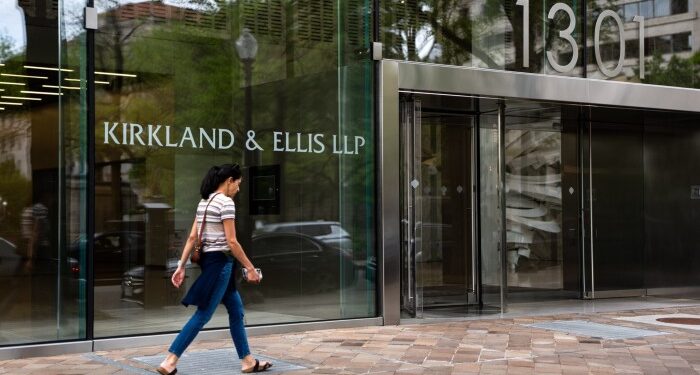Decades ago, long before it was a private-equity powerhouse, the law firm Kirkland & Ellis was a pioneer of a model that overturned a long-standing norm in the legal industry.
The Chicago-founded firm started promoting lawyers to partner without granting them the very thing that defined partnership — an ownership stake in the firm. It was partnership in name only.
The move gave newly promoted “non-equity” partners, with about six years’ experience, an incentive to start proving they could bring in profitable work for the firm. And to the outside world, it put their hourly billing rates on a higher level during some of the most productive years of their career.
It offered a chance to boost profits without diluting returns for the firm’s best-paid lawyers, an elite group of equity-holding partners. But some in the legal industry feared that the move would undermine the prestige of the partnership title that lawyers toiled for years to achieve. “Kirkland kind of handed it out like candy”, a lawyer at a rival firm said.
As Kirkland has risen to become the world’s highest-grossing law firm, earning nearly $9bn in revenues last year, many of its rivals have adopted a similar model, as they attempt to emulate its success. While the model has been popular for decades, even firms that held out for longest are now taking it up, in a sign of how comprehensively the rise of Kirkland and its moneymaking machine has roiled the world of Big Law. Kirkland declined to comment.
Debevoise & Plimpton said this month that it had created a non-equity partnership tier. US rivals Paul Weiss, Cravath, Swaine & Moore and Cleary Gottlieb were among those to do so over the past two years. Meanwhile, Skadden Arps, Ropes & Gray, and the UK-based “magic circle” firm Freshfields — which is making a major push into the US — are all considering the move, according to people with knowledge of the situation.
“The now near-universal adoption of the non-equity partner tier is part of the ‘Kirklandisation’ of Big Law,” said Scott Gibson, founder of legal recruitment consultancy Edwards Gibson.
In all, 87 of the 100 largest law firms now have salaried partners, according to data from the American Lawyer.

Cravath, Paul Weiss, Debevoise, Freshfields and Cleary declined to comment. Skadden didn’t respond to a request for comment and Ropes said its partners “regularly review all aspects of our business to ensure we are best meeting our client needs and talent goals”.
The tier allows young or lower-billing partners to be paid a salary rather than equity from the firm’s profit pool, whilst still holding the partner title and associated prestige.
It was “a leverage play in terms of the economics, how much money you can make off your people”, a partner at a global top-10 firm said. “There’s a tier of hundreds of lawyers who are not eating into the profits of the equity partners — in fact they’re adding to the profits.”
The model helps poach rivals’ best lawyers, by offering them partnership status at a young age. That makes firms vulnerable if they cannot match the offer.
Paul Weiss chair Brad Karp said last year that it had introduced the tier to “address head-on the competitive realities of the current marketplace” after nearly a century of all-equity partnership.

The non-equity tier also offers a solution to another consequence of Kirkland’s rapid rise. The Chicago firm’s growth has forced law firms into a push for expansion, as they seek to avoid falling too far behind.
But hiring more equity partners in such an expansion would dilute the share of the profit pool available to existing partners. That makes the non-equity tier more attractive.
A partner compensation survey of America’s top 200 firms from legal recruiter Major, Lindsey & Africa in 2024 found that equity partners took home more than three times the pay of salaried partners. Average compensation for equity partners was $1.9mn compared with $558,000 for their non-equity colleagues.
At Kirkland, the differential is even more stark: salaried partners take home about $750,000, according to two former partners. That compares with an average profit per equity partner of $9.3mn.

The salaried-partner tier can also save costs: once lawyers are promoted to non-equity partners in the US, they can be on the hook for the full cost of social security and Medicare contributions, rather than splitting it with the firm, according to two people with knowledge of the structure.
Still, not everyone is happy with the arrangements. Last year Meagan Garland, a non-equity partner at Philadelphia-headquartered Duane Morris, sued the firm, alleging that its salaried partners “are in fact employees” but because they were not classified as such, they were denied some benefits and had costs shifted to them. The firm denied misclassification, court documents show. Duane Morris did not immediately respond to a request seeking comment.
Garland’s lawyer said: “The non-equity partner concept takes advantage of a lawyer’s dream of climbing the ladder, while shifting costs away from those who have actual ownership in the firm. Most will never leave the costly purgatory of non-equity partnership.”
At Kirkland, it can have the effect of sifting lawyers. Non-equity partners can be promoted to full partnership after three years, if they prove their value to the firm in that period. Those that don’t make equity partner often leave.
As more firms make the shift, the pressure rises for others to follow — or risk losing lawyers to rivals that have. Still, some firms criticise the two-tier structure for its potential to let non-equity partners overcharge clients because of the title.
A&O Shearman recently phased out the non-equity tier that Shearman & Sterling had when it merged with UK magic circle firm Allen & Overy.
“One of the features […] that we found attractive in terms of the combination was a bit of a return to the structure which we’d had, which was an all equity partnership,” Adam Hakki, co-chair of A&O Shearman’s executive committee said previously. Hakki told the Financial Times this month that he believes the model helps incentivise “firmwide collaboration”.

UK elite firm Slaughter and May is meanwhile still resisting a non-equity partnership tier. A proponent of the now widely abandoned or adapted “lockstep” compensation model, where partners are paid based on experience rather than how much revenue they generate, it is sticking with its traditions.
The firm has long operated on the basis that it promotes young lawyers to partner earlier than its peers, which makes it less vulnerable to its best associates leaving, and has a tightly managed top tier that means less than 10 per cent of its trainees will ever achieve the coveted title.
Mid-tier UK firm Addleshaw Goddard was considering moving away from a stark two-tier partner model to admit more partners into the equity, managing partner Andrew Johnston told the FT. Any change would probably take effect next year, he said.
“All partners at the firm, regardless of level, have similar voting rights and remuneration arrangements and so simplifying the structure would be a natural evolution,” Johnston said.
Some other firms have introduced the model on what one US lawyer describes as a “stealth basis”, such as using the non-equity status in limited circumstances or when hiring lawyers from rivals.
Linklaters maintains a largely all-equity model but has the facility to give non-equity partner status to a minority who practice in niche areas or markets where billing rates are lower. That enables it to promote people without watering down the profit pool for equity partners.
The firms still holding out were taking a risk, the US lawyer said. “Once it’s out there and everyone has it, you’re too at risk of people being poached. It’s a pretty precarious position in this market not to have that flexibility.”
Additional reporting by Arash Massoudi in London






